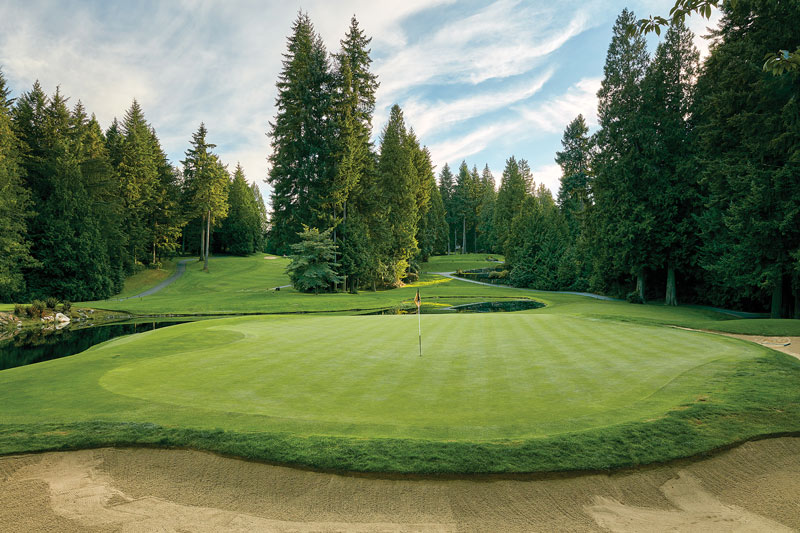
The tree-heavy landscape of Sahalee Country Club in Sammamish, Wash., presents challenges in playability and course maintenance, but the abundant greenery also makes for a memorable, quintessentially Pacific Northwest venue. Photos courtesy of Sahalee Country Club
Editor’s note: This article is part of a series highlighting the important relationship between GCSAA superintendents and PGA of America professionals. These stories are being published simultaneously in both GCM and PGA Magazine.
To say that Sahalee Country Club is renowned for its trees is tantamount to saying nearby Seattle is known for the Seahawks, the Mariners or Starbucks. There are 8,000 trees towering over the 27-hole private club in Sammamish, Wash. — the majority are western red cedar, with a healthy array of Douglas fir, hemlock and big-leaf maples.
It is the daily job of PGA of America general manager/director of golf Jim Pike and superintendent Tom Huesgen, CGCS, and staff to manage Sahalee’s forest-like grounds to ensure the evergreens don’t compromise the integrity, playability and strategy of one of America’s most challenging major championship venues.
Sahalee, the Chinook word for “high heavenly ground,” hosted the 1998 PGA Championship and is preparing for the 2016 KPMG Women’s PGA Championship in June. The golf staff is also maintaining its tradition of everyday excellence for its members with a variety of facility improvement projects spearheaded by Pike, Huesgen and PGA head professional Mike Montgomery. Communication, coordination and collaboration among the golf course operations and maintenance staffs are the three C’s that carry the day at Sahalee.
Daily communication is essential
“Tom and I speak daily, as he advises me on what he and his agronomy team are doing on the golf course,” explains Pike, who has spent 28 years at Sahalee, including the past three years as general manager and director of golf. “At Sahalee, it also is critical for the head golf professional and the superintendent to establish and confirm starting sides on the golf course, since Sahalee is a 27-hole championship golf course where all nines are used and rotated daily. Tom and Mike coordinate the starting sides in a monthly meeting with daily follow-up. Mike, Tom and I meet together at least once a week to coordinate club golf events, golf course setup, course conditions and play schedules.”
Pike says Huesgen provides him and his management team at Sahalee with a weekly update on the status of various projects, such as special chemical applications, turf challenges, aerification, topdressing, tree management, bunker maintenance and irrigation work. “If informed, all of the management team can be great ambassadors for the agronomy team and can communicate to the membership golf course conditions,” Pike says.
Huesgen, a 22-year member of GCSAA who came to Sahalee after successful superintendent tenures at Poppy Hills and Pebble Beach — and time as project manager and superintendent at Cornerstone Golf Club in Montrose, Colo. — agrees that constant communication and coordination are paramount to a successful golf operation.
“We all meet as a staff once a week. But truth be told, a day doesn’t go by that Jim and I don’t talk if we are both on-site,” says Huesgen, who holds a bachelor’s degree from Oregon State University in agricultural science and a degree in psychology and business management from the University of Missouri.

Tom Huesgen (left), PGA head professional Mike Montgomery (center), and Jim Pike.
“Sahalee can be a complex operation, with 27 holes, a passionate golf membership, and several major events on the way,” Huesgen says. “Our meetings cover the gamut, from short-term improvement projects on the golf course to long-term capital improvements, plus everyday maintenance matters. Every meeting includes a progress report and a report on what we are planning to accomplish that day, that week and during the next month.”
Practice range renovations
Since arriving at Sahalee CC nearly two years ago, Huesgen has lent his expertise to a practice range tee renovation project similar to those he championed at Poppy Hills and Pebble Beach. Pike and Huesgen also have tackled a new irrigation renovation project around all the green complexes, and teamed with golf course architect Rees Jones to implement a complex tree management and tree-limbing program. That effort is geared toward restoring Sahalee’s original shot-making corridors from when the course opened in 1969.
During the past three-plus decades, those 8,000 trees have grown taller, thicker and have formed a canopy over some fairways that restrict normal shot-making, which curtails golfer creativity. When the 1998 PGA Championship was contested at Sahalee, the trees were a major topic of conversation. The same situation was encountered when the 2002 NEC Invitational World Golf Championship and the 2010 U.S. Senior Open were staged at Sahalee. Will the trees be an even taller topic at the 2016 KPMG Women’s PGA Championship next June?
“Sahalee has always been known for its natural beauty and its trees,” says Huesgen. “We’re working on a comprehensive tree management plan that has never been in place here before. We have studied aerial photos of the original course, and our objective is to establish a plan that preserves the integrity and strategy of the original layout.”
Those 8,000 large trees shadowing Sahalee’s 27 holes also impact the facility’s irrigation efforts.
“From a grass-growing perspective, the tree density limits air circulation and sunlight, which can be detrimental to turfgrass health,” notes Huesgen. “If the trees block water, you get a lot of hot spots and wet spots. As we carry out our tree-trimming program, it gives us more uniformity in irrigation and eliminates those hot and wet spots.”
If Sahalee was looking for a tree expert, it certainly found one in Huesgen. The Carmel, Calif., resident was entrusted with finding a replacement for the iconic cypress tree fronting the 18th hole at Pebble Beach after the original landmark tree succumbed to lightning and disease and was taken down in 2002. A year later, Huesgen located a proper replacement and headed the transplant process. Today, a tall, healthy tree stands sentinel, guarding the right-front entry to the 18th green at Pebble Beach — just as its predecessor did for so many years.
A major range upgrade
The practice range tee and turf restoration project conducted at Sahalee was another top priority for Pike and Huesgen when the latter returned to the Pacific Northwest, having spent his college days in Corvallis, Ore. Huesgen had just completed a $10 million renovation project at Poppy Hills, which included a redesign of that facility’s practice range.
“Sahalee had approved and budgeted for synthetic turf on the back of the range tee to allow year-round member practice without destroying our grass tee during the winter months,” explains Pike, a PGA professional since 1986. “Tom had just completed a project at Poppy Hills and had watched Pebble Beach install a new synthetic range tee. Tom put together a whole new design for the range tee with a new company for the synthetic turf. We made the pitch to the board of directors for additional funding, and ultimately built a range tee that is first class and available year-round.”
Sahalee was awarded the 2016 KPMG Women’s PGA Championship just last June, which is a short preparation timetable for a major championship. Sahalee’s immaculate daily playing conditions were a factor in the decision, which is a testament to the working relationship among Pike, Huesgen, Montgomery and their staffs.

Sahalee CC is known for its tight, tree-framed fairways and pristine daily playing conditions. Opened in 1969, Sahalee was designed by golf course architect Ted Robinson, and its 27 holes consist of three nine-hole courses. Rees Jones oversaw the redesign and renovations of the bunkers and many prominent features in 1996.
“In preparing for a major championship, I feel the duties and responsibilities are shared, not divided, between the superintendent and general manager,” says Pike, a native of Tacoma, Wash., and a graduate of Brigham Young University. “With all of our championships, I have enjoyed being a part of the planning of the golf course conditions and setup. For the KPMG Championship, I joined Kerry Haigh (PGA chief championships officer) and Tom on the tour of the golf course. I want to know what is being requested of our agronomy team for the upcoming championship so I can support my superintendent.”
Huesgen, who has been involved in staging two U.S. Opens at Pebble Beach and a handful of PGA Tour events, understands that most major championship venues are given five to 10 years to prepare for a major championship.
“That is typical, but fortunately we had already begun our major renovation and improvement projects, so we will be focusing on our normal maintenance programs and completion of the projects already in place,” Huesgen says. “We will spend a lot of time on infrastructure coordination that is necessary to conduct the KPMG Women’s PGA Championship, building new structures to accommodate sponsors and moving spectators seamlessly. Fortunately, we maintain a championship-caliber golf course throughout the year, so we won’t have to make a lot of modifications for this major championship. Sahalee is ready.”
Thanks to the team of Pike and Huesgen and their three C’s, the high heavenly ground of Sahalee Country Club is not only ready for its next major challenge, but is also prepared to provide an impeccable golf experience 365 days a year for the club’s members.
Roger Graves is the senior writer for PGA Magazine.